Assessment 1 CHCPRT001: Child Protection Legislation and Policies
VerifiedAdded on 2023/01/06
|17
|6341
|93
Homework Assignment
AI Summary
This document presents a completed assessment for the CHCPRT001 unit, focusing on identifying and responding to children and young people at risk. The assessment includes questions on child protection legislation, pre-employment screening requirements across different Australian states and territories, and the aims of the National Quality Standard 2.3.4. The student's responses address mandatory reporting, pre-employment checks, and awareness of child protection laws. The assessment adheres to the CHC Community Services Training Package and aligns with AQF level 3, demonstrating the student's understanding of the unit's objectives and the importance of safeguarding children and young people. The document covers a range of topics including the relevant legislation, pre-employment screening, and the National Quality Standard.
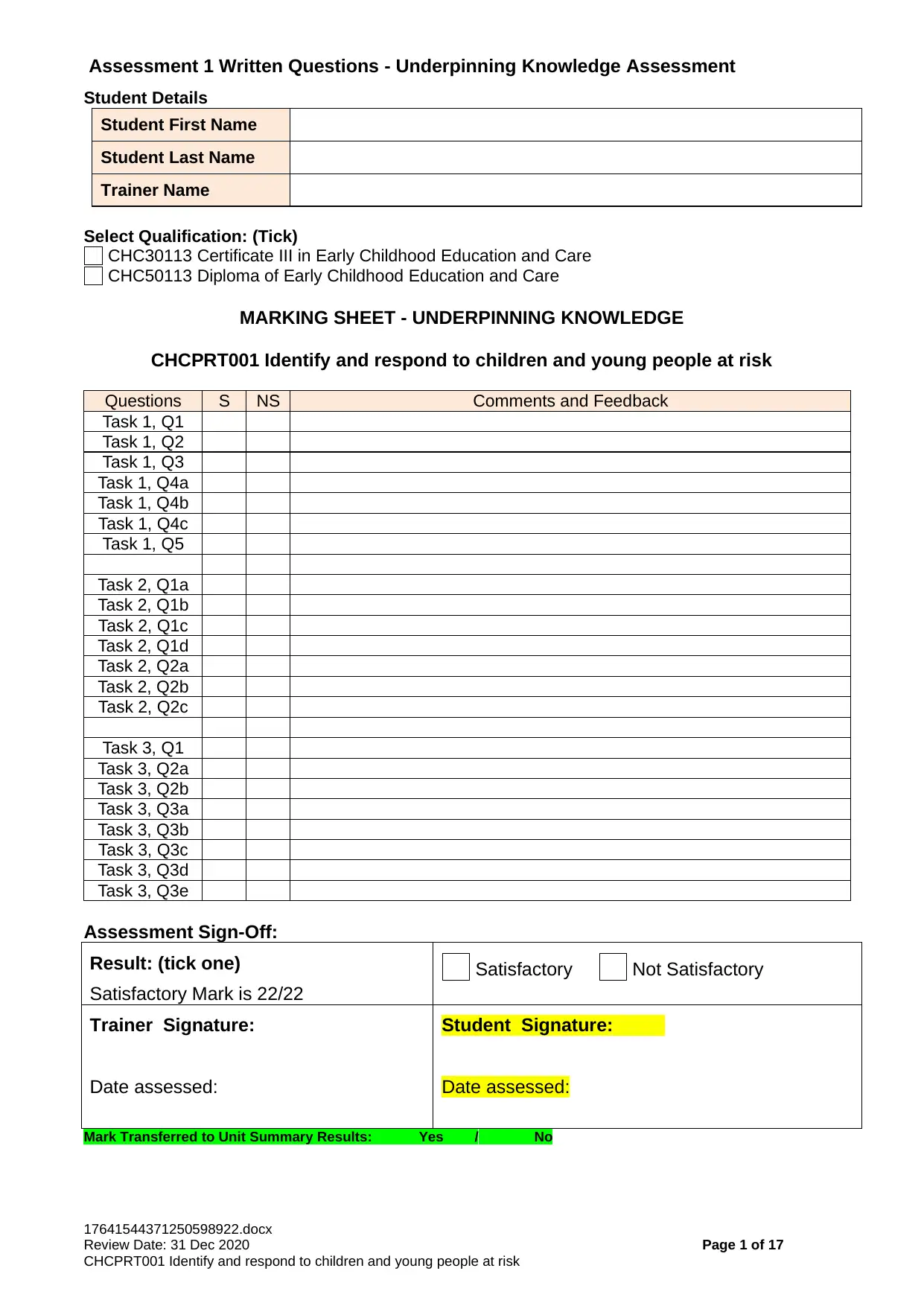
Assessment 1 Written Questions - Underpinning Knowledge Assessment
Student Details
Student First Name
Student Last Name
Trainer Name
Select Qualification: (Tick)
CHC30113 Certificate III in Early Childhood Education and Care
CHC50113 Diploma of Early Childhood Education and Care
MARKING SHEET - UNDERPINNING KNOWLEDGE
CHCPRT001 Identify and respond to children and young people at risk
Questions S NS Comments and Feedback
Task 1, Q1
Task 1, Q2
Task 1, Q3
Task 1, Q4a
Task 1, Q4b
Task 1, Q4c
Task 1, Q5
Task 2, Q1a
Task 2, Q1b
Task 2, Q1c
Task 2, Q1d
Task 2, Q2a
Task 2, Q2b
Task 2, Q2c
Task 3, Q1
Task 3, Q2a
Task 3, Q2b
Task 3, Q3a
Task 3, Q3b
Task 3, Q3c
Task 3, Q3d
Task 3, Q3e
Assessment Sign-Off:
Result: (tick one)
Satisfactory Mark is 22/22
Satisfactory Not Satisfactory
Trainer Signature:
Date assessed:
Student Signature:
Date assessed:
Mark Transferred to Unit Summary Results: Yes / No
17641544371250598922.docx
Review Date: 31 Dec 2020 Page 1 of 17
CHCPRT001 Identify and respond to children and young people at risk
Student Details
Student First Name
Student Last Name
Trainer Name
Select Qualification: (Tick)
CHC30113 Certificate III in Early Childhood Education and Care
CHC50113 Diploma of Early Childhood Education and Care
MARKING SHEET - UNDERPINNING KNOWLEDGE
CHCPRT001 Identify and respond to children and young people at risk
Questions S NS Comments and Feedback
Task 1, Q1
Task 1, Q2
Task 1, Q3
Task 1, Q4a
Task 1, Q4b
Task 1, Q4c
Task 1, Q5
Task 2, Q1a
Task 2, Q1b
Task 2, Q1c
Task 2, Q1d
Task 2, Q2a
Task 2, Q2b
Task 2, Q2c
Task 3, Q1
Task 3, Q2a
Task 3, Q2b
Task 3, Q3a
Task 3, Q3b
Task 3, Q3c
Task 3, Q3d
Task 3, Q3e
Assessment Sign-Off:
Result: (tick one)
Satisfactory Mark is 22/22
Satisfactory Not Satisfactory
Trainer Signature:
Date assessed:
Student Signature:
Date assessed:
Mark Transferred to Unit Summary Results: Yes / No
17641544371250598922.docx
Review Date: 31 Dec 2020 Page 1 of 17
CHCPRT001 Identify and respond to children and young people at risk
Paraphrase This Document
Need a fresh take? Get an instant paraphrase of this document with our AI Paraphraser
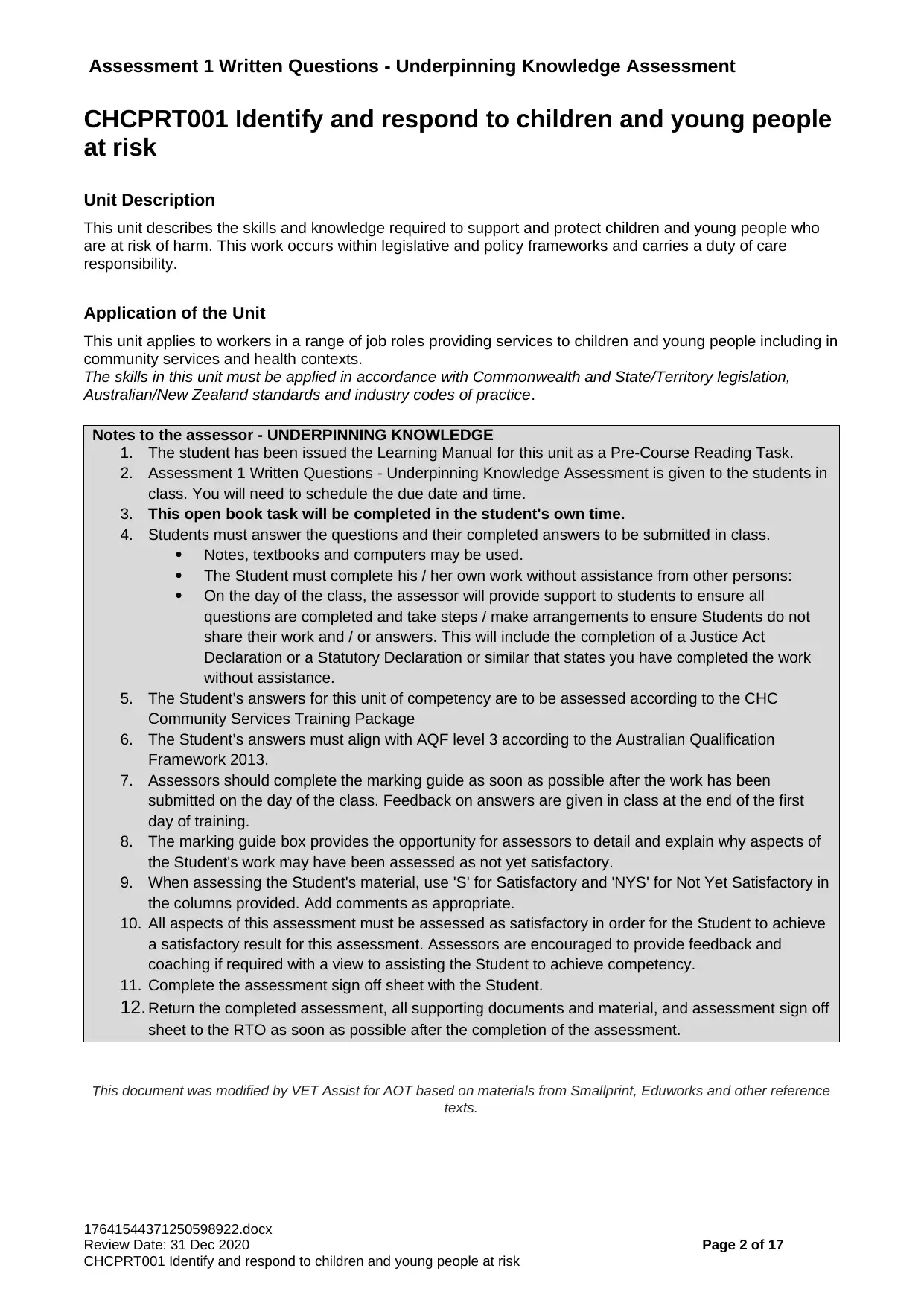
Assessment 1 Written Questions - Underpinning Knowledge Assessment
CHCPRT001 Identify and respond to children and young people
at risk
Unit Description
This unit describes the skills and knowledge required to support and protect children and young people who
are at risk of harm. This work occurs within legislative and policy frameworks and carries a duty of care
responsibility.
Application of the Unit
This unit applies to workers in a range of job roles providing services to children and young people including in
community services and health contexts.
The skills in this unit must be applied in accordance with Commonwealth and State/Territory legislation,
Australian/New Zealand standards and industry codes of practice.
Notes to the assessor - UNDERPINNING KNOWLEDGE
1. The student has been issued the Learning Manual for this unit as a Pre-Course Reading Task.
2. Assessment 1 Written Questions - Underpinning Knowledge Assessment is given to the students in
class. You will need to schedule the due date and time.
3. This open book task will be completed in the student's own time.
4. Students must answer the questions and their completed answers to be submitted in class.
Notes, textbooks and computers may be used.
The Student must complete his / her own work without assistance from other persons:
On the day of the class, the assessor will provide support to students to ensure all
questions are completed and take steps / make arrangements to ensure Students do not
share their work and / or answers. This will include the completion of a Justice Act
Declaration or a Statutory Declaration or similar that states you have completed the work
without assistance.
5. The Student’s answers for this unit of competency are to be assessed according to the CHC
Community Services Training Package
6. The Student’s answers must align with AQF level 3 according to the Australian Qualification
Framework 2013.
7. Assessors should complete the marking guide as soon as possible after the work has been
submitted on the day of the class. Feedback on answers are given in class at the end of the first
day of training.
8. The marking guide box provides the opportunity for assessors to detail and explain why aspects of
the Student's work may have been assessed as not yet satisfactory.
9. When assessing the Student's material, use 'S' for Satisfactory and 'NYS' for Not Yet Satisfactory in
the columns provided. Add comments as appropriate.
10. All aspects of this assessment must be assessed as satisfactory in order for the Student to achieve
a satisfactory result for this assessment. Assessors are encouraged to provide feedback and
coaching if required with a view to assisting the Student to achieve competency.
11. Complete the assessment sign off sheet with the Student.
12. Return the completed assessment, all supporting documents and material, and assessment sign off
sheet to the RTO as soon as possible after the completion of the assessment.
This document was modified by VET Assist for AOT based on materials from Smallprint, Eduworks and other reference
texts.
17641544371250598922.docx
Review Date: 31 Dec 2020 Page 2 of 17
CHCPRT001 Identify and respond to children and young people at risk
CHCPRT001 Identify and respond to children and young people
at risk
Unit Description
This unit describes the skills and knowledge required to support and protect children and young people who
are at risk of harm. This work occurs within legislative and policy frameworks and carries a duty of care
responsibility.
Application of the Unit
This unit applies to workers in a range of job roles providing services to children and young people including in
community services and health contexts.
The skills in this unit must be applied in accordance with Commonwealth and State/Territory legislation,
Australian/New Zealand standards and industry codes of practice.
Notes to the assessor - UNDERPINNING KNOWLEDGE
1. The student has been issued the Learning Manual for this unit as a Pre-Course Reading Task.
2. Assessment 1 Written Questions - Underpinning Knowledge Assessment is given to the students in
class. You will need to schedule the due date and time.
3. This open book task will be completed in the student's own time.
4. Students must answer the questions and their completed answers to be submitted in class.
Notes, textbooks and computers may be used.
The Student must complete his / her own work without assistance from other persons:
On the day of the class, the assessor will provide support to students to ensure all
questions are completed and take steps / make arrangements to ensure Students do not
share their work and / or answers. This will include the completion of a Justice Act
Declaration or a Statutory Declaration or similar that states you have completed the work
without assistance.
5. The Student’s answers for this unit of competency are to be assessed according to the CHC
Community Services Training Package
6. The Student’s answers must align with AQF level 3 according to the Australian Qualification
Framework 2013.
7. Assessors should complete the marking guide as soon as possible after the work has been
submitted on the day of the class. Feedback on answers are given in class at the end of the first
day of training.
8. The marking guide box provides the opportunity for assessors to detail and explain why aspects of
the Student's work may have been assessed as not yet satisfactory.
9. When assessing the Student's material, use 'S' for Satisfactory and 'NYS' for Not Yet Satisfactory in
the columns provided. Add comments as appropriate.
10. All aspects of this assessment must be assessed as satisfactory in order for the Student to achieve
a satisfactory result for this assessment. Assessors are encouraged to provide feedback and
coaching if required with a view to assisting the Student to achieve competency.
11. Complete the assessment sign off sheet with the Student.
12. Return the completed assessment, all supporting documents and material, and assessment sign off
sheet to the RTO as soon as possible after the completion of the assessment.
This document was modified by VET Assist for AOT based on materials from Smallprint, Eduworks and other reference
texts.
17641544371250598922.docx
Review Date: 31 Dec 2020 Page 2 of 17
CHCPRT001 Identify and respond to children and young people at risk
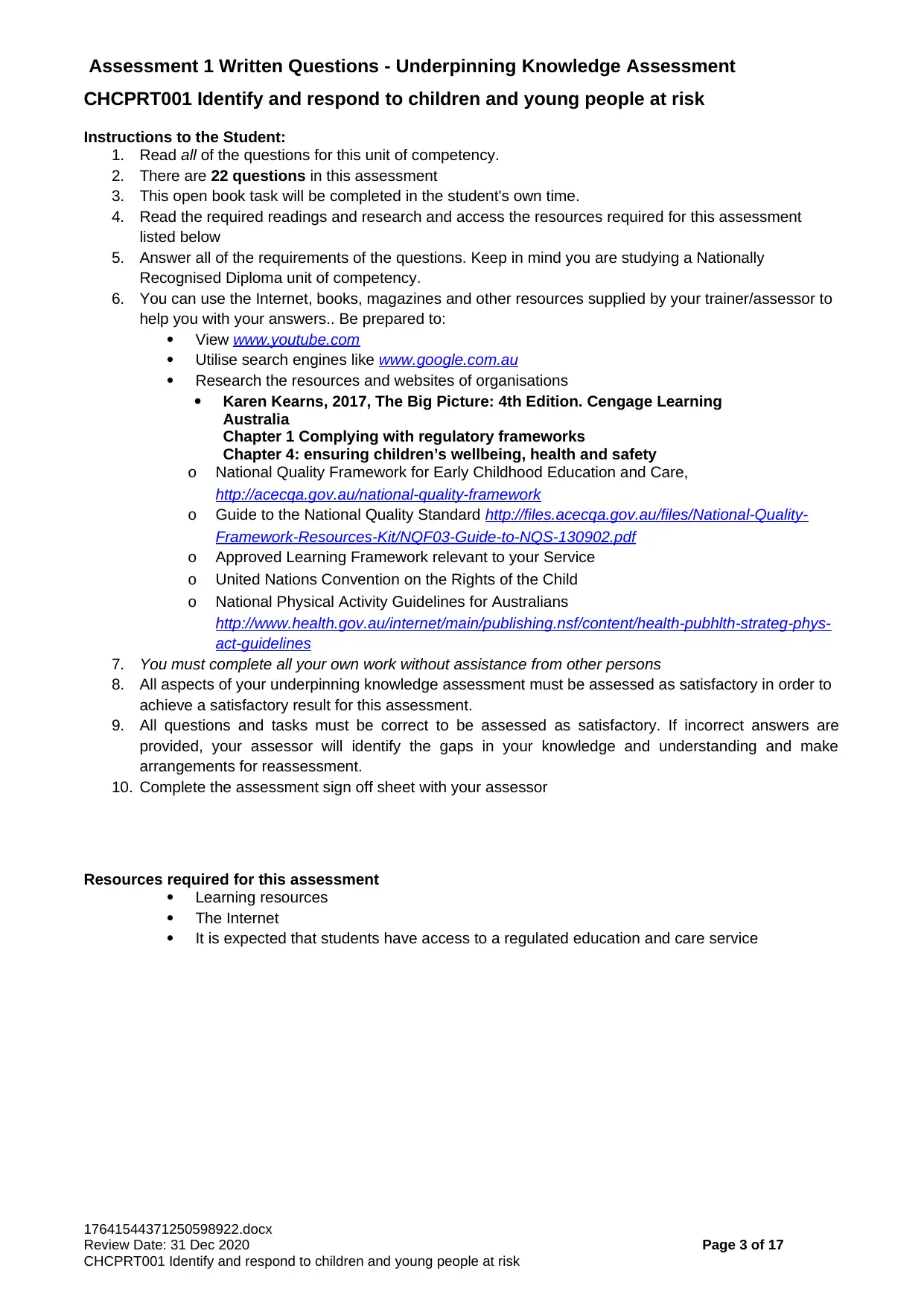
Assessment 1 Written Questions - Underpinning Knowledge Assessment
CHCPRT001 Identify and respond to children and young people at risk
Instructions to the Student:
1. Read all of the questions for this unit of competency.
2. There are 22 questions in this assessment
3. This open book task will be completed in the student's own time.
4. Read the required readings and research and access the resources required for this assessment
listed below
5. Answer all of the requirements of the questions. Keep in mind you are studying a Nationally
Recognised Diploma unit of competency.
6. You can use the Internet, books, magazines and other resources supplied by your trainer/assessor to
help you with your answers.. Be prepared to:
View www.youtube.com
Utilise search engines like www.google.com.au
Research the resources and websites of organisations
Karen Kearns, 2017, The Big Picture: 4th Edition. Cengage Learning
Australia
Chapter 1 Complying with regulatory frameworks
Chapter 4: ensuring children’s wellbeing, health and safety
o National Quality Framework for Early Childhood Education and Care,
http://acecqa.gov.au/national-quality-framework
o Guide to the National Quality Standard http://files.acecqa.gov.au/files/National-Quality-
Framework-Resources-Kit/NQF03-Guide-to-NQS-130902.pdf
o Approved Learning Framework relevant to your Service
o United Nations Convention on the Rights of the Child
o National Physical Activity Guidelines for Australians
http://www.health.gov.au/internet/main/publishing.nsf/content/health-pubhlth-strateg-phys-
act-guidelines
7. You must complete all your own work without assistance from other persons
8. All aspects of your underpinning knowledge assessment must be assessed as satisfactory in order to
achieve a satisfactory result for this assessment.
9. All questions and tasks must be correct to be assessed as satisfactory. If incorrect answers are
provided, your assessor will identify the gaps in your knowledge and understanding and make
arrangements for reassessment.
10. Complete the assessment sign off sheet with your assessor
Resources required for this assessment
Learning resources
The Internet
It is expected that students have access to a regulated education and care service
17641544371250598922.docx
Review Date: 31 Dec 2020 Page 3 of 17
CHCPRT001 Identify and respond to children and young people at risk
CHCPRT001 Identify and respond to children and young people at risk
Instructions to the Student:
1. Read all of the questions for this unit of competency.
2. There are 22 questions in this assessment
3. This open book task will be completed in the student's own time.
4. Read the required readings and research and access the resources required for this assessment
listed below
5. Answer all of the requirements of the questions. Keep in mind you are studying a Nationally
Recognised Diploma unit of competency.
6. You can use the Internet, books, magazines and other resources supplied by your trainer/assessor to
help you with your answers.. Be prepared to:
View www.youtube.com
Utilise search engines like www.google.com.au
Research the resources and websites of organisations
Karen Kearns, 2017, The Big Picture: 4th Edition. Cengage Learning
Australia
Chapter 1 Complying with regulatory frameworks
Chapter 4: ensuring children’s wellbeing, health and safety
o National Quality Framework for Early Childhood Education and Care,
http://acecqa.gov.au/national-quality-framework
o Guide to the National Quality Standard http://files.acecqa.gov.au/files/National-Quality-
Framework-Resources-Kit/NQF03-Guide-to-NQS-130902.pdf
o Approved Learning Framework relevant to your Service
o United Nations Convention on the Rights of the Child
o National Physical Activity Guidelines for Australians
http://www.health.gov.au/internet/main/publishing.nsf/content/health-pubhlth-strateg-phys-
act-guidelines
7. You must complete all your own work without assistance from other persons
8. All aspects of your underpinning knowledge assessment must be assessed as satisfactory in order to
achieve a satisfactory result for this assessment.
9. All questions and tasks must be correct to be assessed as satisfactory. If incorrect answers are
provided, your assessor will identify the gaps in your knowledge and understanding and make
arrangements for reassessment.
10. Complete the assessment sign off sheet with your assessor
Resources required for this assessment
Learning resources
The Internet
It is expected that students have access to a regulated education and care service
17641544371250598922.docx
Review Date: 31 Dec 2020 Page 3 of 17
CHCPRT001 Identify and respond to children and young people at risk
⊘ This is a preview!⊘
Do you want full access?
Subscribe today to unlock all pages.

Trusted by 1+ million students worldwide
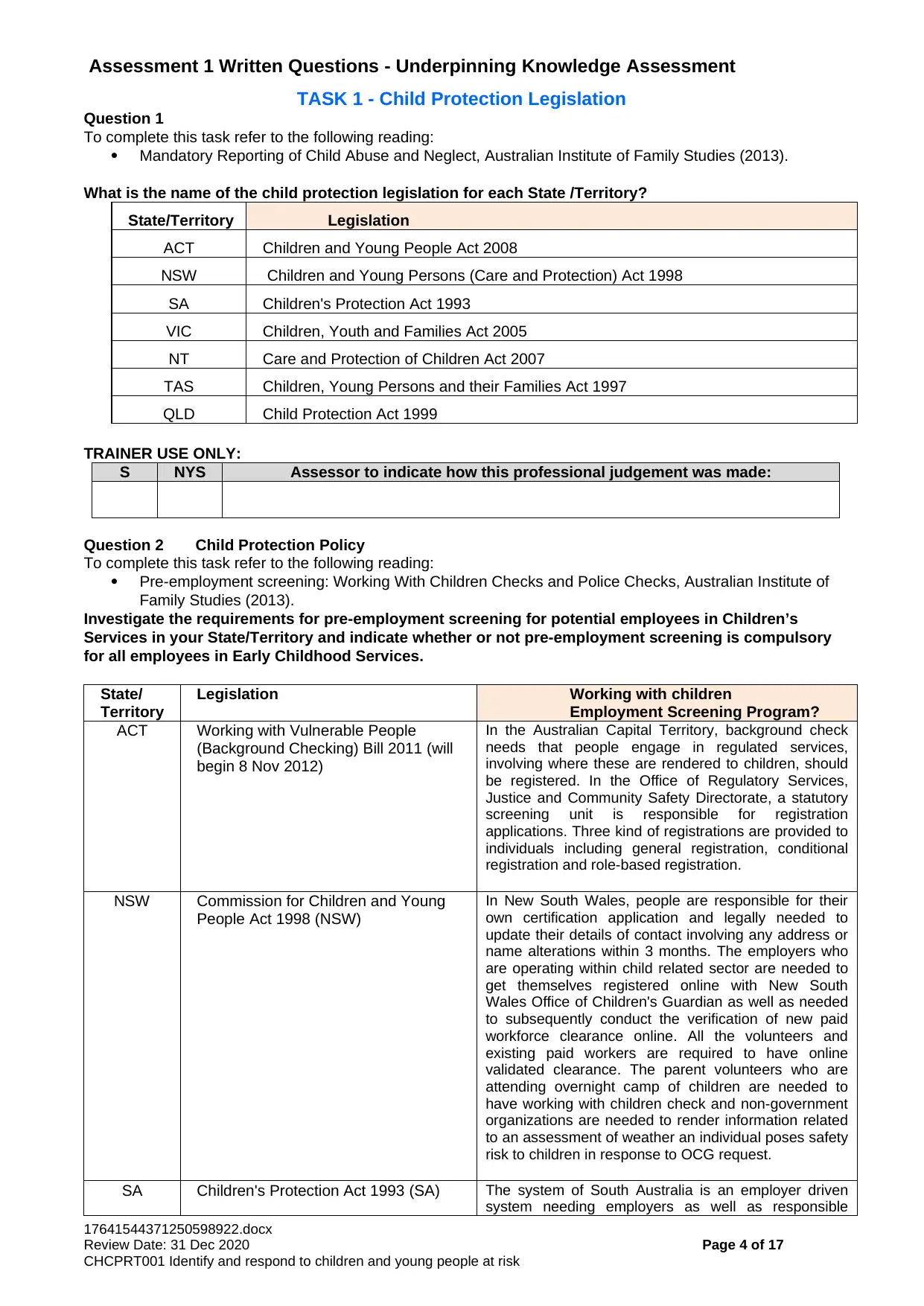
Assessment 1 Written Questions - Underpinning Knowledge Assessment
TASK 1 - Child Protection Legislation
Question 1
To complete this task refer to the following reading:
Mandatory Reporting of Child Abuse and Neglect, Australian Institute of Family Studies (2013).
What is the name of the child protection legislation for each State /Territory?
State/Territory Legislation
ACT Children and Young People Act 2008
NSW Children and Young Persons (Care and Protection) Act 1998
SA Children's Protection Act 1993
VIC Children, Youth and Families Act 2005
NT Care and Protection of Children Act 2007
TAS Children, Young Persons and their Families Act 1997
QLD Child Protection Act 1999
TRAINER USE ONLY:
S NYS Assessor to indicate how this professional judgement was made:
Question 2 Child Protection Policy
To complete this task refer to the following reading:
Pre-employment screening: Working With Children Checks and Police Checks, Australian Institute of
Family Studies (2013).
Investigate the requirements for pre-employment screening for potential employees in Children’s
Services in your State/Territory and indicate whether or not pre-employment screening is compulsory
for all employees in Early Childhood Services.
State/
Territory
Legislation Working with children
Employment Screening Program?
ACT Working with Vulnerable People
(Background Checking) Bill 2011 (will
begin 8 Nov 2012)
In the Australian Capital Territory, background check
needs that people engage in regulated services,
involving where these are rendered to children, should
be registered. In the Office of Regulatory Services,
Justice and Community Safety Directorate, a statutory
screening unit is responsible for registration
applications. Three kind of registrations are provided to
individuals including general registration, conditional
registration and role-based registration.
NSW Commission for Children and Young
People Act 1998 (NSW)
In New South Wales, people are responsible for their
own certification application and legally needed to
update their details of contact involving any address or
name alterations within 3 months. The employers who
are operating within child related sector are needed to
get themselves registered online with New South
Wales Office of Children's Guardian as well as needed
to subsequently conduct the verification of new paid
workforce clearance online. All the volunteers and
existing paid workers are required to have online
validated clearance. The parent volunteers who are
attending overnight camp of children are needed to
have working with children check and non-government
organizations are needed to render information related
to an assessment of weather an individual poses safety
risk to children in response to OCG request.
SA Children's Protection Act 1993 (SA) The system of South Australia is an employer driven
system needing employers as well as responsible
17641544371250598922.docx
Review Date: 31 Dec 2020 Page 4 of 17
CHCPRT001 Identify and respond to children and young people at risk
TASK 1 - Child Protection Legislation
Question 1
To complete this task refer to the following reading:
Mandatory Reporting of Child Abuse and Neglect, Australian Institute of Family Studies (2013).
What is the name of the child protection legislation for each State /Territory?
State/Territory Legislation
ACT Children and Young People Act 2008
NSW Children and Young Persons (Care and Protection) Act 1998
SA Children's Protection Act 1993
VIC Children, Youth and Families Act 2005
NT Care and Protection of Children Act 2007
TAS Children, Young Persons and their Families Act 1997
QLD Child Protection Act 1999
TRAINER USE ONLY:
S NYS Assessor to indicate how this professional judgement was made:
Question 2 Child Protection Policy
To complete this task refer to the following reading:
Pre-employment screening: Working With Children Checks and Police Checks, Australian Institute of
Family Studies (2013).
Investigate the requirements for pre-employment screening for potential employees in Children’s
Services in your State/Territory and indicate whether or not pre-employment screening is compulsory
for all employees in Early Childhood Services.
State/
Territory
Legislation Working with children
Employment Screening Program?
ACT Working with Vulnerable People
(Background Checking) Bill 2011 (will
begin 8 Nov 2012)
In the Australian Capital Territory, background check
needs that people engage in regulated services,
involving where these are rendered to children, should
be registered. In the Office of Regulatory Services,
Justice and Community Safety Directorate, a statutory
screening unit is responsible for registration
applications. Three kind of registrations are provided to
individuals including general registration, conditional
registration and role-based registration.
NSW Commission for Children and Young
People Act 1998 (NSW)
In New South Wales, people are responsible for their
own certification application and legally needed to
update their details of contact involving any address or
name alterations within 3 months. The employers who
are operating within child related sector are needed to
get themselves registered online with New South
Wales Office of Children's Guardian as well as needed
to subsequently conduct the verification of new paid
workforce clearance online. All the volunteers and
existing paid workers are required to have online
validated clearance. The parent volunteers who are
attending overnight camp of children are needed to
have working with children check and non-government
organizations are needed to render information related
to an assessment of weather an individual poses safety
risk to children in response to OCG request.
SA Children's Protection Act 1993 (SA) The system of South Australia is an employer driven
system needing employers as well as responsible
17641544371250598922.docx
Review Date: 31 Dec 2020 Page 4 of 17
CHCPRT001 Identify and respond to children and young people at risk
Paraphrase This Document
Need a fresh take? Get an instant paraphrase of this document with our AI Paraphraser
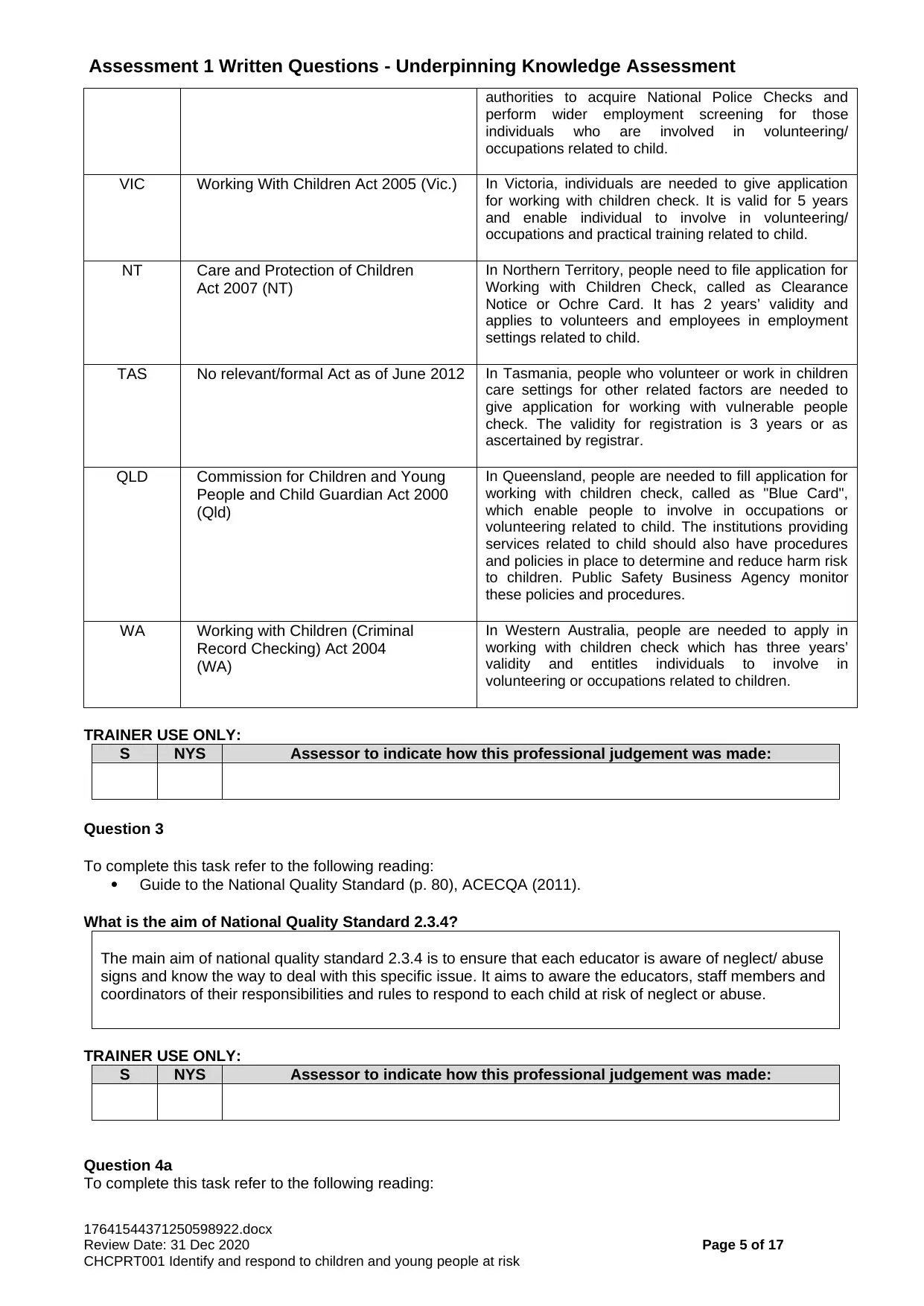
Assessment 1 Written Questions - Underpinning Knowledge Assessment
authorities to acquire National Police Checks and
perform wider employment screening for those
individuals who are involved in volunteering/
occupations related to child.
VIC Working With Children Act 2005 (Vic.) In Victoria, individuals are needed to give application
for working with children check. It is valid for 5 years
and enable individual to involve in volunteering/
occupations and practical training related to child.
NT Care and Protection of Children
Act 2007 (NT)
In Northern Territory, people need to file application for
Working with Children Check, called as Clearance
Notice or Ochre Card. It has 2 years’ validity and
applies to volunteers and employees in employment
settings related to child.
TAS No relevant/formal Act as of June 2012 In Tasmania, people who volunteer or work in children
care settings for other related factors are needed to
give application for working with vulnerable people
check. The validity for registration is 3 years or as
ascertained by registrar.
QLD Commission for Children and Young
People and Child Guardian Act 2000
(Qld)
In Queensland, people are needed to fill application for
working with children check, called as "Blue Card",
which enable people to involve in occupations or
volunteering related to child. The institutions providing
services related to child should also have procedures
and policies in place to determine and reduce harm risk
to children. Public Safety Business Agency monitor
these policies and procedures.
WA Working with Children (Criminal
Record Checking) Act 2004
(WA)
In Western Australia, people are needed to apply in
working with children check which has three years’
validity and entitles individuals to involve in
volunteering or occupations related to children.
TRAINER USE ONLY:
S NYS Assessor to indicate how this professional judgement was made:
Question 3
To complete this task refer to the following reading:
Guide to the National Quality Standard (p. 80), ACECQA (2011).
What is the aim of National Quality Standard 2.3.4?
The main aim of national quality standard 2.3.4 is to ensure that each educator is aware of neglect/ abuse
signs and know the way to deal with this specific issue. It aims to aware the educators, staff members and
coordinators of their responsibilities and rules to respond to each child at risk of neglect or abuse.
TRAINER USE ONLY:
S NYS Assessor to indicate how this professional judgement was made:
Question 4a
To complete this task refer to the following reading:
17641544371250598922.docx
Review Date: 31 Dec 2020 Page 5 of 17
CHCPRT001 Identify and respond to children and young people at risk
authorities to acquire National Police Checks and
perform wider employment screening for those
individuals who are involved in volunteering/
occupations related to child.
VIC Working With Children Act 2005 (Vic.) In Victoria, individuals are needed to give application
for working with children check. It is valid for 5 years
and enable individual to involve in volunteering/
occupations and practical training related to child.
NT Care and Protection of Children
Act 2007 (NT)
In Northern Territory, people need to file application for
Working with Children Check, called as Clearance
Notice or Ochre Card. It has 2 years’ validity and
applies to volunteers and employees in employment
settings related to child.
TAS No relevant/formal Act as of June 2012 In Tasmania, people who volunteer or work in children
care settings for other related factors are needed to
give application for working with vulnerable people
check. The validity for registration is 3 years or as
ascertained by registrar.
QLD Commission for Children and Young
People and Child Guardian Act 2000
(Qld)
In Queensland, people are needed to fill application for
working with children check, called as "Blue Card",
which enable people to involve in occupations or
volunteering related to child. The institutions providing
services related to child should also have procedures
and policies in place to determine and reduce harm risk
to children. Public Safety Business Agency monitor
these policies and procedures.
WA Working with Children (Criminal
Record Checking) Act 2004
(WA)
In Western Australia, people are needed to apply in
working with children check which has three years’
validity and entitles individuals to involve in
volunteering or occupations related to children.
TRAINER USE ONLY:
S NYS Assessor to indicate how this professional judgement was made:
Question 3
To complete this task refer to the following reading:
Guide to the National Quality Standard (p. 80), ACECQA (2011).
What is the aim of National Quality Standard 2.3.4?
The main aim of national quality standard 2.3.4 is to ensure that each educator is aware of neglect/ abuse
signs and know the way to deal with this specific issue. It aims to aware the educators, staff members and
coordinators of their responsibilities and rules to respond to each child at risk of neglect or abuse.
TRAINER USE ONLY:
S NYS Assessor to indicate how this professional judgement was made:
Question 4a
To complete this task refer to the following reading:
17641544371250598922.docx
Review Date: 31 Dec 2020 Page 5 of 17
CHCPRT001 Identify and respond to children and young people at risk
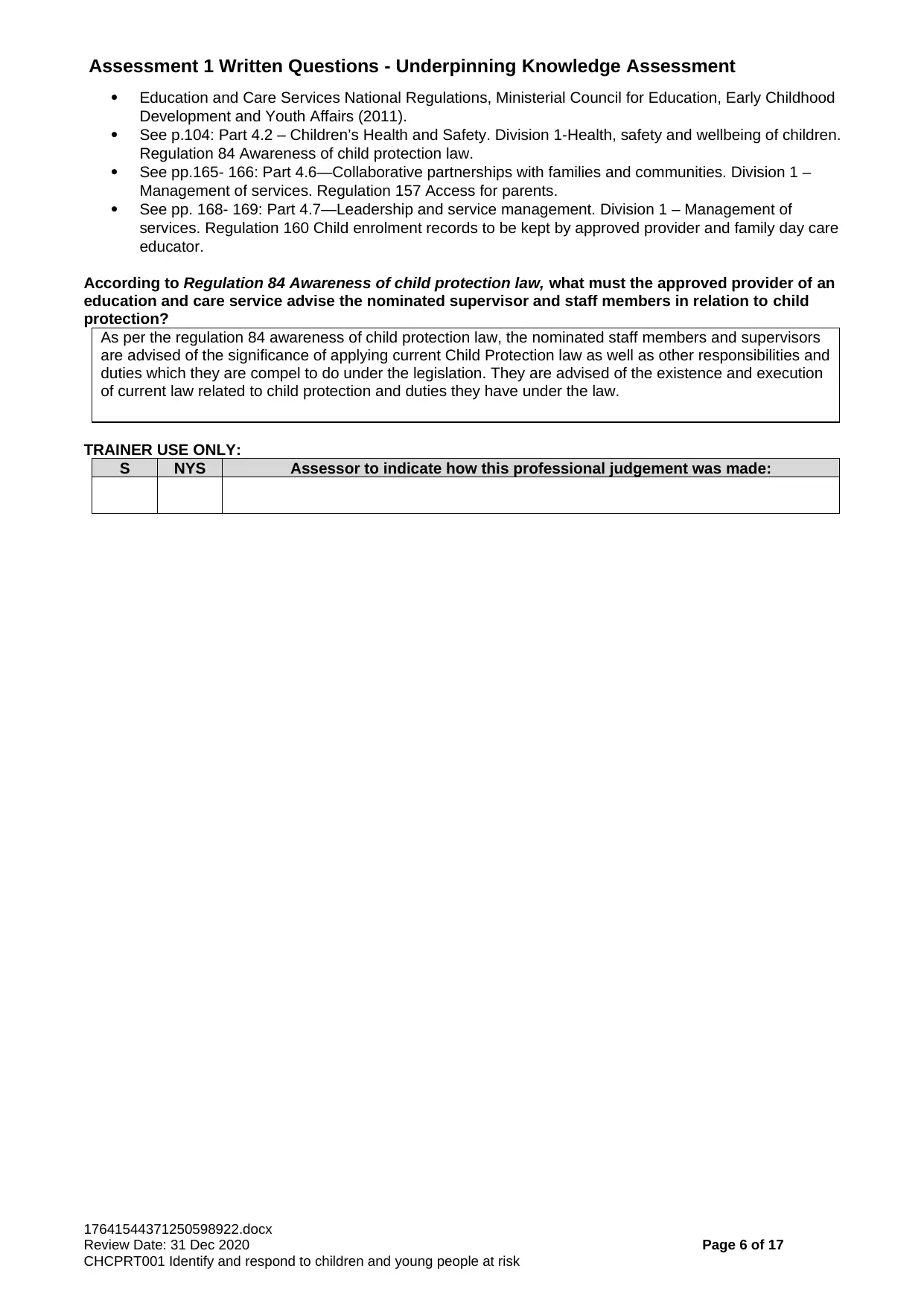
Assessment 1 Written Questions - Underpinning Knowledge Assessment
Education and Care Services National Regulations, Ministerial Council for Education, Early Childhood
Development and Youth Affairs (2011).
See p.104: Part 4.2 – Children’s Health and Safety. Division 1-Health, safety and wellbeing of children.
Regulation 84 Awareness of child protection law.
See pp.165- 166: Part 4.6—Collaborative partnerships with families and communities. Division 1 –
Management of services. Regulation 157 Access for parents.
See pp. 168- 169: Part 4.7—Leadership and service management. Division 1 – Management of
services. Regulation 160 Child enrolment records to be kept by approved provider and family day care
educator.
According to Regulation 84 Awareness of child protection law, what must the approved provider of an
education and care service advise the nominated supervisor and staff members in relation to child
protection?
As per the regulation 84 awareness of child protection law, the nominated staff members and supervisors
are advised of the significance of applying current Child Protection law as well as other responsibilities and
duties which they are compel to do under the legislation. They are advised of the existence and execution
of current law related to child protection and duties they have under the law.
TRAINER USE ONLY:
S NYS Assessor to indicate how this professional judgement was made:
17641544371250598922.docx
Review Date: 31 Dec 2020 Page 6 of 17
CHCPRT001 Identify and respond to children and young people at risk
Education and Care Services National Regulations, Ministerial Council for Education, Early Childhood
Development and Youth Affairs (2011).
See p.104: Part 4.2 – Children’s Health and Safety. Division 1-Health, safety and wellbeing of children.
Regulation 84 Awareness of child protection law.
See pp.165- 166: Part 4.6—Collaborative partnerships with families and communities. Division 1 –
Management of services. Regulation 157 Access for parents.
See pp. 168- 169: Part 4.7—Leadership and service management. Division 1 – Management of
services. Regulation 160 Child enrolment records to be kept by approved provider and family day care
educator.
According to Regulation 84 Awareness of child protection law, what must the approved provider of an
education and care service advise the nominated supervisor and staff members in relation to child
protection?
As per the regulation 84 awareness of child protection law, the nominated staff members and supervisors
are advised of the significance of applying current Child Protection law as well as other responsibilities and
duties which they are compel to do under the legislation. They are advised of the existence and execution
of current law related to child protection and duties they have under the law.
TRAINER USE ONLY:
S NYS Assessor to indicate how this professional judgement was made:
17641544371250598922.docx
Review Date: 31 Dec 2020 Page 6 of 17
CHCPRT001 Identify and respond to children and young people at risk
⊘ This is a preview!⊘
Do you want full access?
Subscribe today to unlock all pages.

Trusted by 1+ million students worldwide
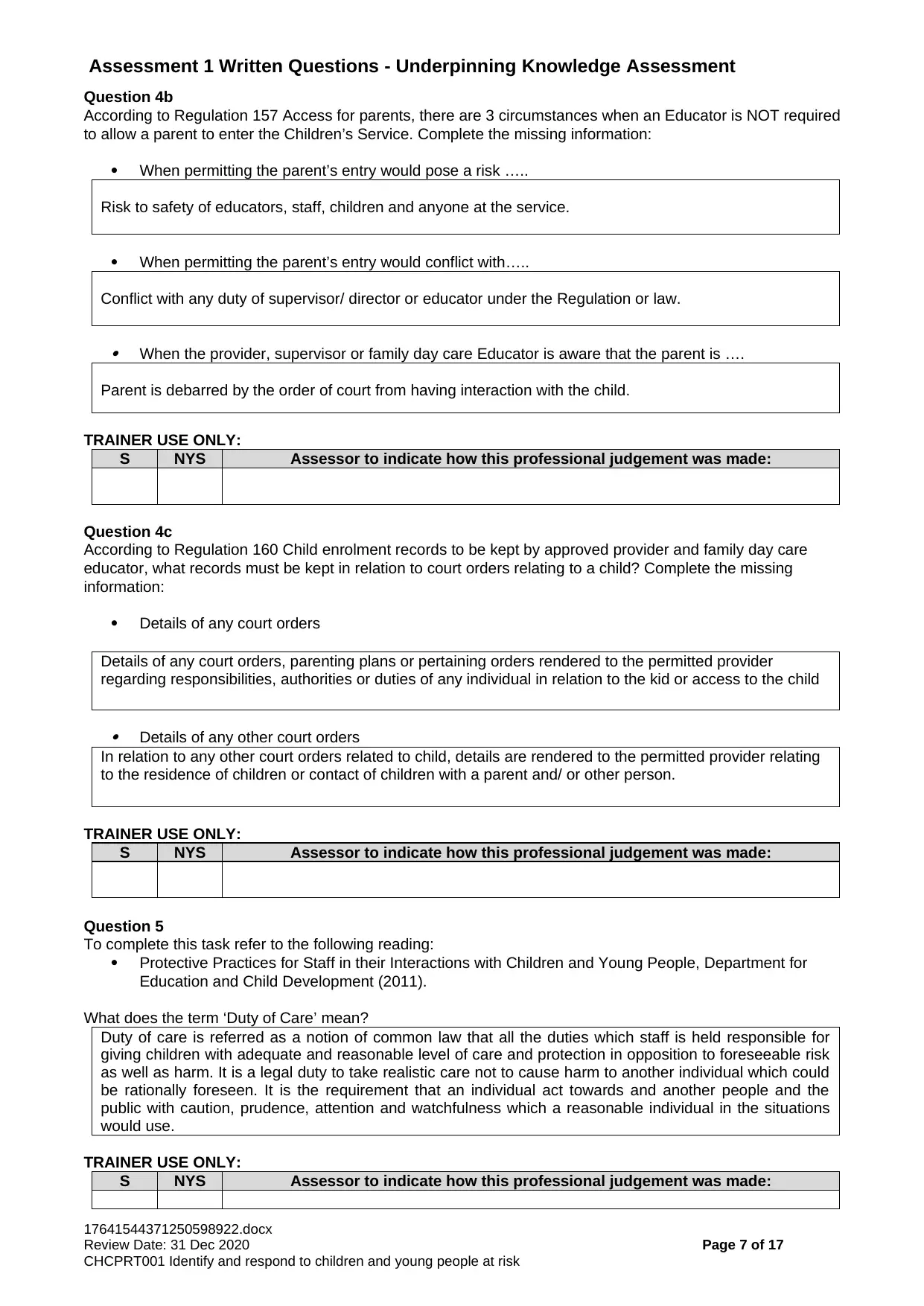
Assessment 1 Written Questions - Underpinning Knowledge Assessment
Question 4b
According to Regulation 157 Access for parents, there are 3 circumstances when an Educator is NOT required
to allow a parent to enter the Children’s Service. Complete the missing information:
When permitting the parent’s entry would pose a risk …..
Risk to safety of educators, staff, children and anyone at the service.
When permitting the parent’s entry would conflict with…..
Conflict with any duty of supervisor/ director or educator under the Regulation or law.
When the provider, supervisor or family day care Educator is aware that the parent is ….
Parent is debarred by the order of court from having interaction with the child.
TRAINER USE ONLY:
S NYS Assessor to indicate how this professional judgement was made:
Question 4c
According to Regulation 160 Child enrolment records to be kept by approved provider and family day care
educator, what records must be kept in relation to court orders relating to a child? Complete the missing
information:
Details of any court orders
Details of any court orders, parenting plans or pertaining orders rendered to the permitted provider
regarding responsibilities, authorities or duties of any individual in relation to the kid or access to the child
Details of any other court orders
In relation to any other court orders related to child, details are rendered to the permitted provider relating
to the residence of children or contact of children with a parent and/ or other person.
TRAINER USE ONLY:
S NYS Assessor to indicate how this professional judgement was made:
Question 5
To complete this task refer to the following reading:
Protective Practices for Staff in their Interactions with Children and Young People, Department for
Education and Child Development (2011).
What does the term ‘Duty of Care’ mean?
Duty of care is referred as a notion of common law that all the duties which staff is held responsible for
giving children with adequate and reasonable level of care and protection in opposition to foreseeable risk
as well as harm. It is a legal duty to take realistic care not to cause harm to another individual which could
be rationally foreseen. It is the requirement that an individual act towards and another people and the
public with caution, prudence, attention and watchfulness which a reasonable individual in the situations
would use.
TRAINER USE ONLY:
S NYS Assessor to indicate how this professional judgement was made:
17641544371250598922.docx
Review Date: 31 Dec 2020 Page 7 of 17
CHCPRT001 Identify and respond to children and young people at risk
Question 4b
According to Regulation 157 Access for parents, there are 3 circumstances when an Educator is NOT required
to allow a parent to enter the Children’s Service. Complete the missing information:
When permitting the parent’s entry would pose a risk …..
Risk to safety of educators, staff, children and anyone at the service.
When permitting the parent’s entry would conflict with…..
Conflict with any duty of supervisor/ director or educator under the Regulation or law.
When the provider, supervisor or family day care Educator is aware that the parent is ….
Parent is debarred by the order of court from having interaction with the child.
TRAINER USE ONLY:
S NYS Assessor to indicate how this professional judgement was made:
Question 4c
According to Regulation 160 Child enrolment records to be kept by approved provider and family day care
educator, what records must be kept in relation to court orders relating to a child? Complete the missing
information:
Details of any court orders
Details of any court orders, parenting plans or pertaining orders rendered to the permitted provider
regarding responsibilities, authorities or duties of any individual in relation to the kid or access to the child
Details of any other court orders
In relation to any other court orders related to child, details are rendered to the permitted provider relating
to the residence of children or contact of children with a parent and/ or other person.
TRAINER USE ONLY:
S NYS Assessor to indicate how this professional judgement was made:
Question 5
To complete this task refer to the following reading:
Protective Practices for Staff in their Interactions with Children and Young People, Department for
Education and Child Development (2011).
What does the term ‘Duty of Care’ mean?
Duty of care is referred as a notion of common law that all the duties which staff is held responsible for
giving children with adequate and reasonable level of care and protection in opposition to foreseeable risk
as well as harm. It is a legal duty to take realistic care not to cause harm to another individual which could
be rationally foreseen. It is the requirement that an individual act towards and another people and the
public with caution, prudence, attention and watchfulness which a reasonable individual in the situations
would use.
TRAINER USE ONLY:
S NYS Assessor to indicate how this professional judgement was made:
17641544371250598922.docx
Review Date: 31 Dec 2020 Page 7 of 17
CHCPRT001 Identify and respond to children and young people at risk
Paraphrase This Document
Need a fresh take? Get an instant paraphrase of this document with our AI Paraphraser
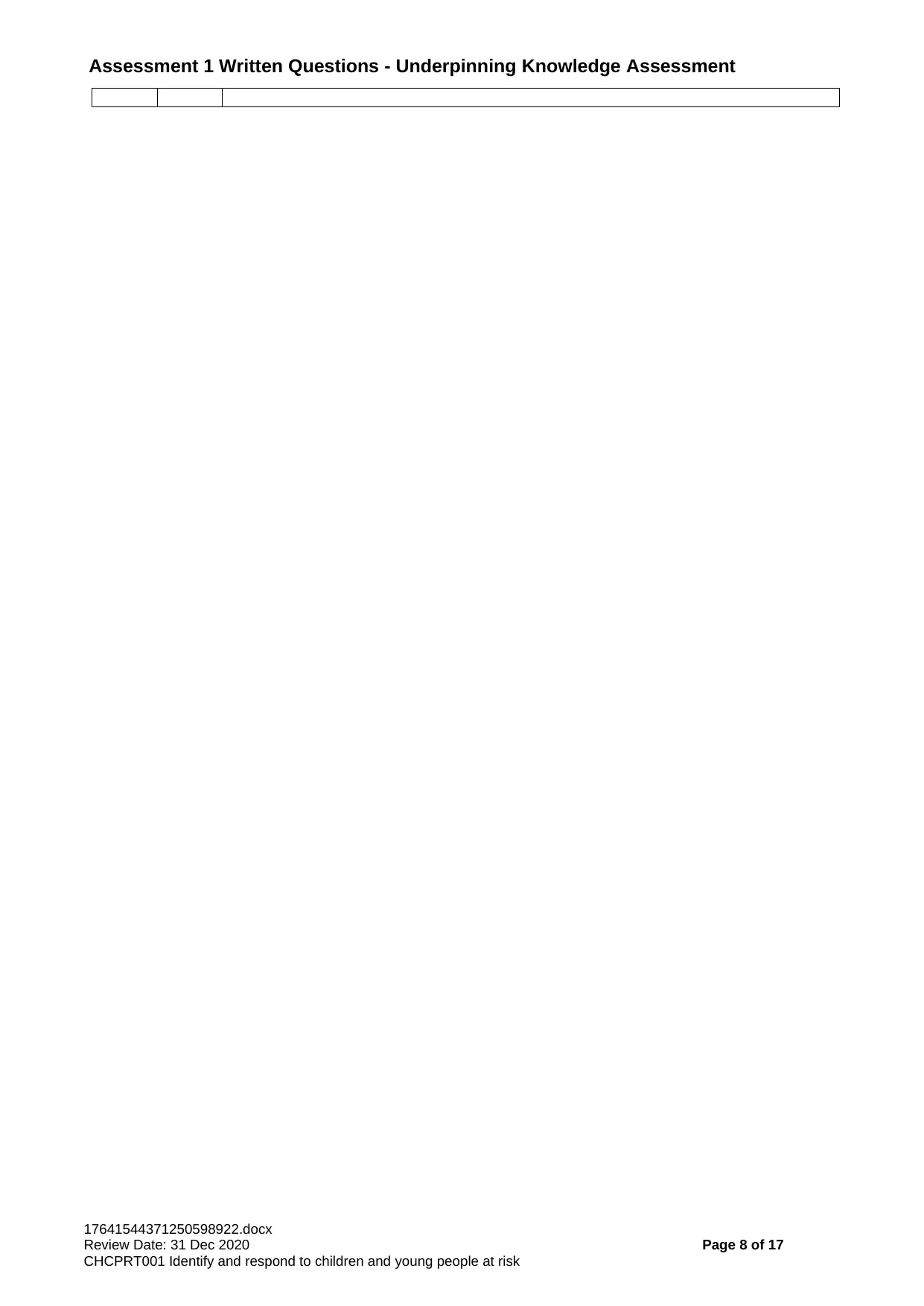
Assessment 1 Written Questions - Underpinning Knowledge Assessment
17641544371250598922.docx
Review Date: 31 Dec 2020 Page 8 of 17
CHCPRT001 Identify and respond to children and young people at risk
17641544371250598922.docx
Review Date: 31 Dec 2020 Page 8 of 17
CHCPRT001 Identify and respond to children and young people at risk
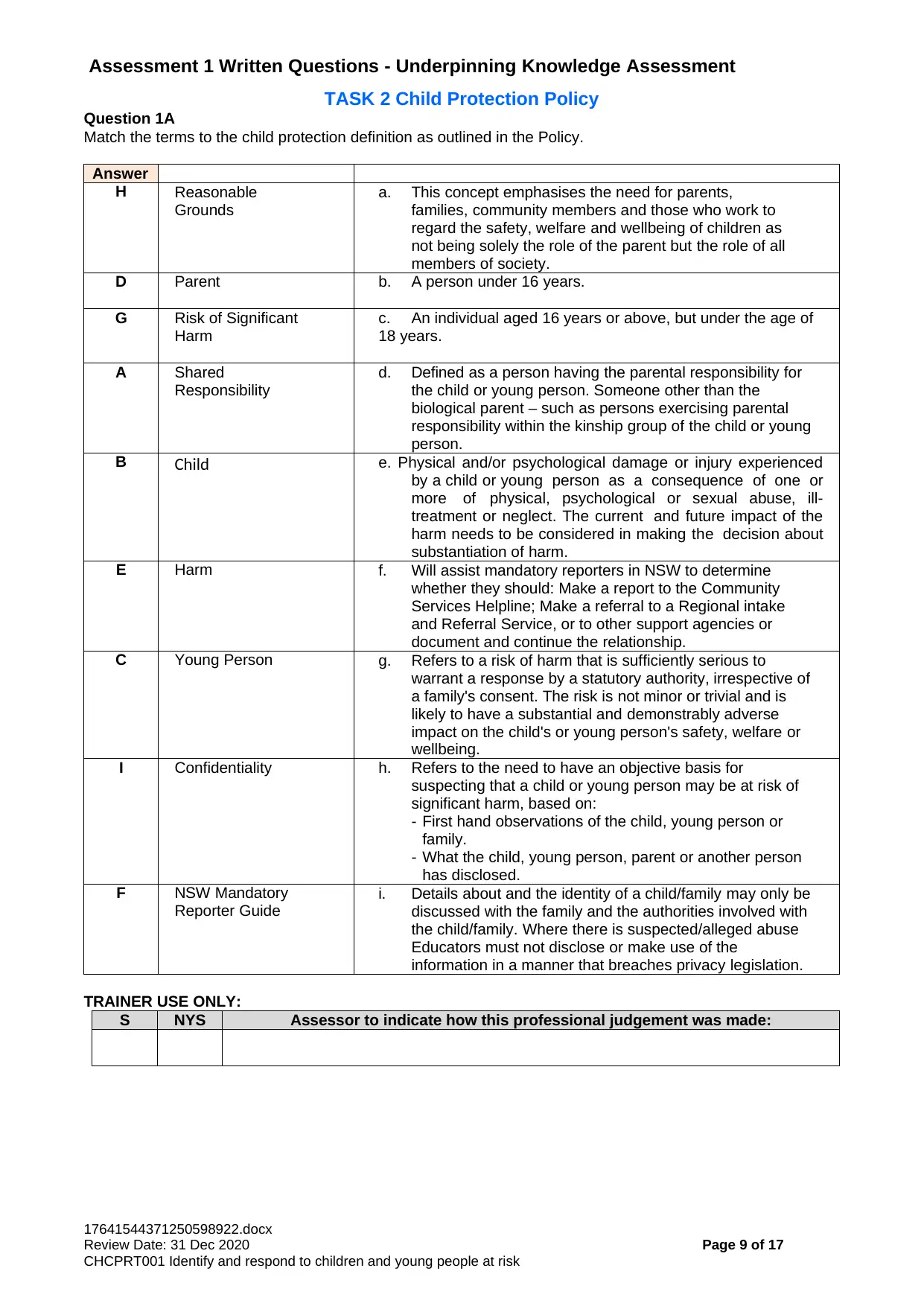
Assessment 1 Written Questions - Underpinning Knowledge Assessment
TASK 2 Child Protection Policy
Question 1A
Match the terms to the child protection definition as outlined in the Policy.
Answer
H Reasonable
Grounds
a. This concept emphasises the need for parents,
families, community members and those who work to
regard the safety, welfare and wellbeing of children as
not being solely the role of the parent but the role of all
members of society.
D Parent b. A person under 16 years.
G Risk of Significant
Harm
c. An individual aged 16 years or above, but under the age of
18 years.
A Shared
Responsibility
d. Defined as a person having the parental responsibility for
the child or young person. Someone other than the
biological parent – such as persons exercising parental
responsibility within the kinship group of the child or young
person.
B Child e. Physical and/or psychological damage or injury experienced
by a child or young person as a consequence of one or
more of physical, psychological or sexual abuse, ill-
treatment or neglect. The current and future impact of the
harm needs to be considered in making the decision about
substantiation of harm.
E Harm f. Will assist mandatory reporters in NSW to determine
whether they should: Make a report to the Community
Services Helpline; Make a referral to a Regional intake
and Referral Service, or to other support agencies or
document and continue the relationship.
C Young Person g. Refers to a risk of harm that is sufficiently serious to
warrant a response by a statutory authority, irrespective of
a family's consent. The risk is not minor or trivial and is
likely to have a substantial and demonstrably adverse
impact on the child's or young person's safety, welfare or
wellbeing.
I Confidentiality h. Refers to the need to have an objective basis for
suspecting that a child or young person may be at risk of
significant harm, based on:
- First hand observations of the child, young person or
family.
- What the child, young person, parent or another person
has disclosed.
F NSW Mandatory
Reporter Guide
i. Details about and the identity of a child/family may only be
discussed with the family and the authorities involved with
the child/family. Where there is suspected/alleged abuse
Educators must not disclose or make use of the
information in a manner that breaches privacy legislation.
TRAINER USE ONLY:
S NYS Assessor to indicate how this professional judgement was made:
17641544371250598922.docx
Review Date: 31 Dec 2020 Page 9 of 17
CHCPRT001 Identify and respond to children and young people at risk
TASK 2 Child Protection Policy
Question 1A
Match the terms to the child protection definition as outlined in the Policy.
Answer
H Reasonable
Grounds
a. This concept emphasises the need for parents,
families, community members and those who work to
regard the safety, welfare and wellbeing of children as
not being solely the role of the parent but the role of all
members of society.
D Parent b. A person under 16 years.
G Risk of Significant
Harm
c. An individual aged 16 years or above, but under the age of
18 years.
A Shared
Responsibility
d. Defined as a person having the parental responsibility for
the child or young person. Someone other than the
biological parent – such as persons exercising parental
responsibility within the kinship group of the child or young
person.
B Child e. Physical and/or psychological damage or injury experienced
by a child or young person as a consequence of one or
more of physical, psychological or sexual abuse, ill-
treatment or neglect. The current and future impact of the
harm needs to be considered in making the decision about
substantiation of harm.
E Harm f. Will assist mandatory reporters in NSW to determine
whether they should: Make a report to the Community
Services Helpline; Make a referral to a Regional intake
and Referral Service, or to other support agencies or
document and continue the relationship.
C Young Person g. Refers to a risk of harm that is sufficiently serious to
warrant a response by a statutory authority, irrespective of
a family's consent. The risk is not minor or trivial and is
likely to have a substantial and demonstrably adverse
impact on the child's or young person's safety, welfare or
wellbeing.
I Confidentiality h. Refers to the need to have an objective basis for
suspecting that a child or young person may be at risk of
significant harm, based on:
- First hand observations of the child, young person or
family.
- What the child, young person, parent or another person
has disclosed.
F NSW Mandatory
Reporter Guide
i. Details about and the identity of a child/family may only be
discussed with the family and the authorities involved with
the child/family. Where there is suspected/alleged abuse
Educators must not disclose or make use of the
information in a manner that breaches privacy legislation.
TRAINER USE ONLY:
S NYS Assessor to indicate how this professional judgement was made:
17641544371250598922.docx
Review Date: 31 Dec 2020 Page 9 of 17
CHCPRT001 Identify and respond to children and young people at risk
⊘ This is a preview!⊘
Do you want full access?
Subscribe today to unlock all pages.

Trusted by 1+ million students worldwide

Assessment 1 Written Questions - Underpinning Knowledge Assessment
Question 1B
The ‘Blue Bay Model Child Protection Policy’ outlines the conditions that must be present in order to
make a report of significant risk of harm. What are these conditions?
The conditions which must be present to make a report of significant risk of harm includes:
1. Physical abuse
2. Sexual abuse
3. Psychological harm
4. Neglect
Food
Medical care
Education
Supervision
Physical care
Mental health care
Shelter/ Environment
5. Problematic sexual behaviour
6. Unborn child
7. Carer concerns
parent / carer substance abuse
parent / carer domestic violence
parent / carer mental health
8. Relinquishing care
TRAINER USE ONLY:
S NYS Assessor to indicate how this professional judgement was made:
Question 1C
What are staff required to do if it is considered that the child is at immediate risk of harm?
If it is considered that child is at immediate risk of harm, then the staff is required to directly contact to the
police and the helpline.
TRAINER USE ONLY:
S NYS Assessor to indicate how this professional judgement was made:
17641544371250598922.docx
Review Date: 31 Dec 2020 Page 10 of 17
CHCPRT001 Identify and respond to children and young people at risk
Question 1B
The ‘Blue Bay Model Child Protection Policy’ outlines the conditions that must be present in order to
make a report of significant risk of harm. What are these conditions?
The conditions which must be present to make a report of significant risk of harm includes:
1. Physical abuse
2. Sexual abuse
3. Psychological harm
4. Neglect
Food
Medical care
Education
Supervision
Physical care
Mental health care
Shelter/ Environment
5. Problematic sexual behaviour
6. Unborn child
7. Carer concerns
parent / carer substance abuse
parent / carer domestic violence
parent / carer mental health
8. Relinquishing care
TRAINER USE ONLY:
S NYS Assessor to indicate how this professional judgement was made:
Question 1C
What are staff required to do if it is considered that the child is at immediate risk of harm?
If it is considered that child is at immediate risk of harm, then the staff is required to directly contact to the
police and the helpline.
TRAINER USE ONLY:
S NYS Assessor to indicate how this professional judgement was made:
17641544371250598922.docx
Review Date: 31 Dec 2020 Page 10 of 17
CHCPRT001 Identify and respond to children and young people at risk
Paraphrase This Document
Need a fresh take? Get an instant paraphrase of this document with our AI Paraphraser
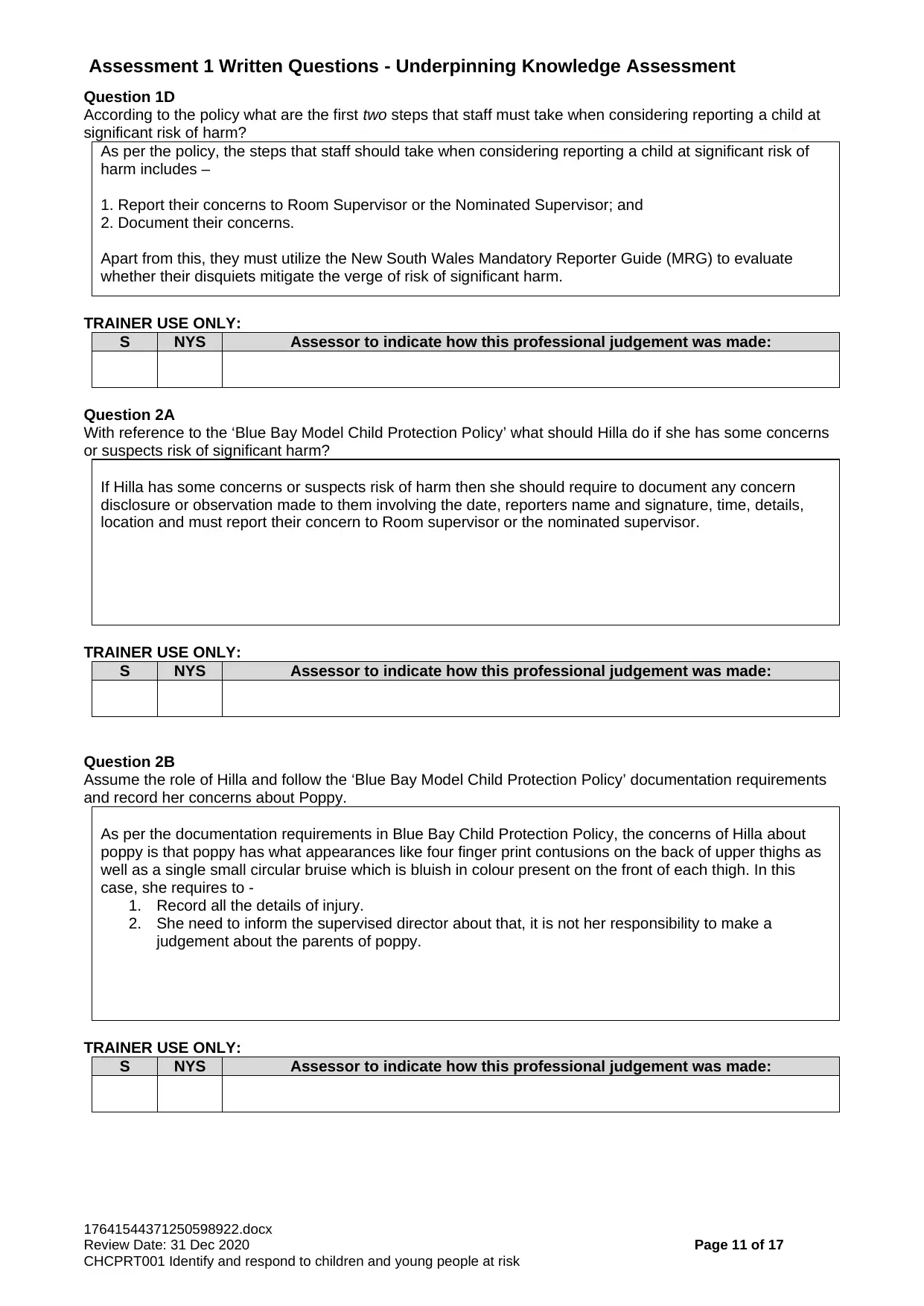
Assessment 1 Written Questions - Underpinning Knowledge Assessment
Question 1D
According to the policy what are the first two steps that staff must take when considering reporting a child at
significant risk of harm?
As per the policy, the steps that staff should take when considering reporting a child at significant risk of
harm includes –
1. Report their concerns to Room Supervisor or the Nominated Supervisor; and
2. Document their concerns.
Apart from this, they must utilize the New South Wales Mandatory Reporter Guide (MRG) to evaluate
whether their disquiets mitigate the verge of risk of significant harm.
TRAINER USE ONLY:
S NYS Assessor to indicate how this professional judgement was made:
Question 2A
With reference to the ‘Blue Bay Model Child Protection Policy’ what should Hilla do if she has some concerns
or suspects risk of significant harm?
If Hilla has some concerns or suspects risk of harm then she should require to document any concern
disclosure or observation made to them involving the date, reporters name and signature, time, details,
location and must report their concern to Room supervisor or the nominated supervisor.
TRAINER USE ONLY:
S NYS Assessor to indicate how this professional judgement was made:
Question 2B
Assume the role of Hilla and follow the ‘Blue Bay Model Child Protection Policy’ documentation requirements
and record her concerns about Poppy.
As per the documentation requirements in Blue Bay Child Protection Policy, the concerns of Hilla about
poppy is that poppy has what appearances like four finger print contusions on the back of upper thighs as
well as a single small circular bruise which is bluish in colour present on the front of each thigh. In this
case, she requires to -
1. Record all the details of injury.
2. She need to inform the supervised director about that, it is not her responsibility to make a
judgement about the parents of poppy.
TRAINER USE ONLY:
S NYS Assessor to indicate how this professional judgement was made:
17641544371250598922.docx
Review Date: 31 Dec 2020 Page 11 of 17
CHCPRT001 Identify and respond to children and young people at risk
Question 1D
According to the policy what are the first two steps that staff must take when considering reporting a child at
significant risk of harm?
As per the policy, the steps that staff should take when considering reporting a child at significant risk of
harm includes –
1. Report their concerns to Room Supervisor or the Nominated Supervisor; and
2. Document their concerns.
Apart from this, they must utilize the New South Wales Mandatory Reporter Guide (MRG) to evaluate
whether their disquiets mitigate the verge of risk of significant harm.
TRAINER USE ONLY:
S NYS Assessor to indicate how this professional judgement was made:
Question 2A
With reference to the ‘Blue Bay Model Child Protection Policy’ what should Hilla do if she has some concerns
or suspects risk of significant harm?
If Hilla has some concerns or suspects risk of harm then she should require to document any concern
disclosure or observation made to them involving the date, reporters name and signature, time, details,
location and must report their concern to Room supervisor or the nominated supervisor.
TRAINER USE ONLY:
S NYS Assessor to indicate how this professional judgement was made:
Question 2B
Assume the role of Hilla and follow the ‘Blue Bay Model Child Protection Policy’ documentation requirements
and record her concerns about Poppy.
As per the documentation requirements in Blue Bay Child Protection Policy, the concerns of Hilla about
poppy is that poppy has what appearances like four finger print contusions on the back of upper thighs as
well as a single small circular bruise which is bluish in colour present on the front of each thigh. In this
case, she requires to -
1. Record all the details of injury.
2. She need to inform the supervised director about that, it is not her responsibility to make a
judgement about the parents of poppy.
TRAINER USE ONLY:
S NYS Assessor to indicate how this professional judgement was made:
17641544371250598922.docx
Review Date: 31 Dec 2020 Page 11 of 17
CHCPRT001 Identify and respond to children and young people at risk
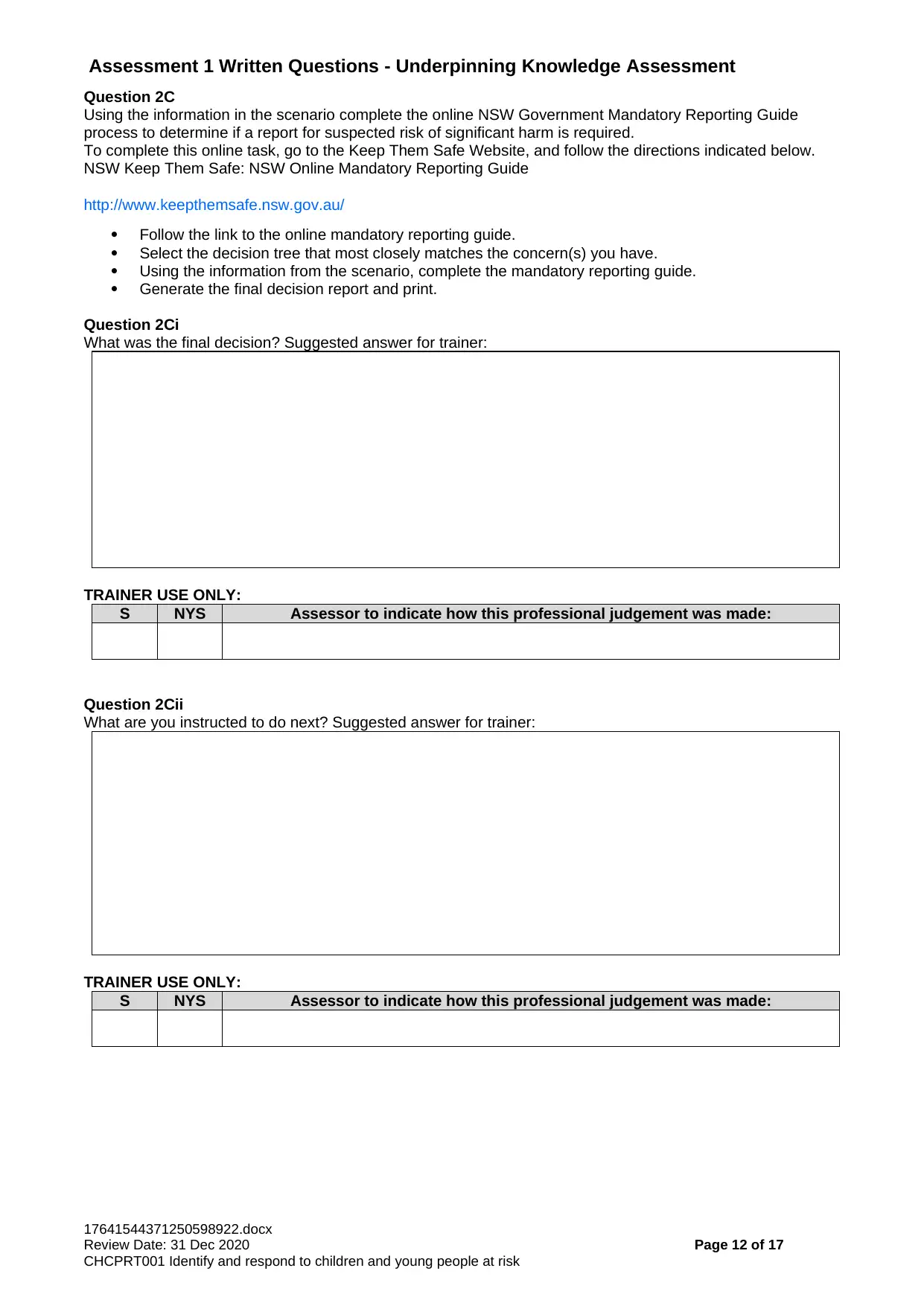
Assessment 1 Written Questions - Underpinning Knowledge Assessment
Question 2C
Using the information in the scenario complete the online NSW Government Mandatory Reporting Guide
process to determine if a report for suspected risk of significant harm is required.
To complete this online task, go to the Keep Them Safe Website, and follow the directions indicated below.
NSW Keep Them Safe: NSW Online Mandatory Reporting Guide
http://www.keepthemsafe.nsw.gov.au/
Follow the link to the online mandatory reporting guide.
Select the decision tree that most closely matches the concern(s) you have.
Using the information from the scenario, complete the mandatory reporting guide.
Generate the final decision report and print.
Question 2Ci
What was the final decision? Suggested answer for trainer:
TRAINER USE ONLY:
S NYS Assessor to indicate how this professional judgement was made:
Question 2Cii
What are you instructed to do next? Suggested answer for trainer:
TRAINER USE ONLY:
S NYS Assessor to indicate how this professional judgement was made:
17641544371250598922.docx
Review Date: 31 Dec 2020 Page 12 of 17
CHCPRT001 Identify and respond to children and young people at risk
Question 2C
Using the information in the scenario complete the online NSW Government Mandatory Reporting Guide
process to determine if a report for suspected risk of significant harm is required.
To complete this online task, go to the Keep Them Safe Website, and follow the directions indicated below.
NSW Keep Them Safe: NSW Online Mandatory Reporting Guide
http://www.keepthemsafe.nsw.gov.au/
Follow the link to the online mandatory reporting guide.
Select the decision tree that most closely matches the concern(s) you have.
Using the information from the scenario, complete the mandatory reporting guide.
Generate the final decision report and print.
Question 2Ci
What was the final decision? Suggested answer for trainer:
TRAINER USE ONLY:
S NYS Assessor to indicate how this professional judgement was made:
Question 2Cii
What are you instructed to do next? Suggested answer for trainer:
TRAINER USE ONLY:
S NYS Assessor to indicate how this professional judgement was made:
17641544371250598922.docx
Review Date: 31 Dec 2020 Page 12 of 17
CHCPRT001 Identify and respond to children and young people at risk
⊘ This is a preview!⊘
Do you want full access?
Subscribe today to unlock all pages.

Trusted by 1+ million students worldwide
1 out of 17
Related Documents
Your All-in-One AI-Powered Toolkit for Academic Success.
+13062052269
info@desklib.com
Available 24*7 on WhatsApp / Email
![[object Object]](/_next/static/media/star-bottom.7253800d.svg)
Unlock your academic potential
Copyright © 2020–2025 A2Z Services. All Rights Reserved. Developed and managed by ZUCOL.





